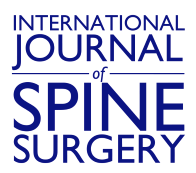
Abstract
INTRODUCTION: Studies suggest significant biomechanical and clinical differences exist between total disk replacement (TDR) and anterior cervical discectomy and fusion (ACDF) patients treated at multiple cervical levels. However, long-term results for treatment of multilevel cervical degenerative disc disease are lacking. Here we evaluate 7-year neurological and clinical outcomes of patients treated at 2 contiguous levels with TDR or ACDF.
METHODS: Prospective, randomized, multicenter, controlled clinical trial. The study cohort consisted of 225 patients receiving TDR and 105 patients receiving ACDF with allograft and anterior plate. Patients were treated at 2 contiguous levels from C3 to C7. Outcomes measured at 7 years included neurological deterioration, device-related adverse events, visual analog scale (VAS) neck and arm pain, subsequent surgeries, and range of motion. Neurological deterioration was assessed as any decrease in motor, sensory, or reflex assessment.
RESULTS: At 7 years, 13.4% of TDR and 34.2% of ACDF patients had neurological deterioration (P = .001). Device-related neurological adverse events (AEs) were significantly lower for TDR (5.1% vs 11.4%; P = .04). Neurological adverse events were most frequently sensory related (3.0% vs 4.8%) rather than motor (0.9% vs 1.9%) or reflex (0.4% vs 1.0%) neurological events. VAS neck (18.7 vs 29.7) and arm pain (15.2 vs 18.8) were lower in TDR patients compared with ACDF patients, although these differences were not statistically significant. Device-related subsequent surgeries were significantly lower for TDR (4.9% vs 16.2%; P= .001). Patients with TDR maintained flexion-extension range of motion at both the superior (9.4°) and inferior (7.5°) treated levels.
CONCLUSION: Treatment with 2-level TDR demonstrated better long-term neurological outcomes compared with ACDF. Neurological deterioration and adverse events were significantly better with TDR, with neurological events most frequently being sensory related. TDR patients had fewer subsequent surgeries and less neck and arm pain, while maintaining range of motion.
To Read The Full Article Click Here





